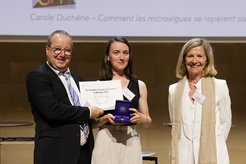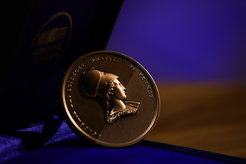Carole Duchêne honoured by the French Academy of Sciences for Microalgae Research
Carole Duchêne was recognised by the French Academy of Sciences, receiving the prestigious 2025 Grandes Avancées françaises en biologie (Major French Advances in Biology) award. The ceremony, held in the grand hall of the French Institute in Paris on 17 June 2025, celebrated Duchêne's work on how marine microalgae navigate the ocean's depths.

In brief

- Carole Duchêne received the prestigious 2025 "Major French Advances in Biology" award from the French Academy of Sciences for her research on how marine microalgae navigate ocean depths.
- Her work revealed that diatom phytochromes act as "depth probes," enabling microalgae to adapt their photosynthesis to the varying light conditions found at different ocean depths.
- This discovery, linking molecular findings to environmental data, highlights a novel function for photoreceptor proteins in algae, likely an adaptation to their aquatic environment.
On the 20th anniversary of the les Grandes Avancées françaises en biologie, 17 June 2025, Carole Duchêne presented her research findings, a culmination of her work under the supervision of Angela Falciatore and Marianne Jaubert from the Institut de biologie physico-chimique in Paris.
“This work represents a significant part of my PhD. Its publication in Nature was already a huge success, but having it recognised by l’Académie des sciences further validates the findings. It also brings visibility to my research and that of my PhD laboratory.”
From proteins to the depths of the ocean
Light plays a crucial role in ocean life, serving as an energy source for photosynthesis and a crucial environmental cue for organisms like diatoms, which are vital marine microalgae. Duchêne’s research focused on diatom phytochromes, specialised light perception proteins. While phytochromes are known in plants for their sensitivity to red and far-red light, Duchêne and her team discovered that diatom phytochromes possess unique photochemical properties, allowing them to perceive the subtle variations in the water column's blue and green light spectrum, a characteristic of the deep ocean. This ability is particularly useful in temperate and polar oceans, where the upper water layer is highly mixed.
"The phytochrome essentially acts as a depth probe," explains Carole Duchêne. "It allows diatoms to adapt their photosynthesis to the specific light spectrum they are exposed to. This ability is especially critical in temperate and polar oceans, where the upper water layers are highly turbulent, causing diatoms to experience significant light fluctuations."
She was drawn to the project due to its interdisciplinary nature, combining “cellular biology, plant physiology, genetics and the context of photoperception in algae.” Her passion lies in “studying biology at all scales, from proteins to the ocean.” This research was developed as part of her Master's degree, and she continued it throughout her PhD at Sorbonne University in Paris.
Her work aims to understand how organisms interact with each other and their environment. This involves formulating hypotheses based on environmental data, validating them in the lab and vice versa, and then using these findings to refine our understanding of ocean life.
One of their key discoveries is that the photoreceptor exists in both algae and plants, but responds to different lights in algae. This new mechanism likely represents a specific adaptation of algae to their aquatic environment. The strength of this research lies in its ability to connect this initial molecular discovery with broader environmental data, including oceanographic and environmental genomic information, as well as cellular physiology. This integrated approach strongly suggests that this photoperception system has a significant impact on our marine environment.
To date, Carole continues her research within the Department of Algal Development and Evolution at the Max Planck Institute for Biology in Tübingen, where she studies the infection of brown algae by marine viruses. She wants to understand the mechanisms that couple the virus cycle to the algal life cycle.

